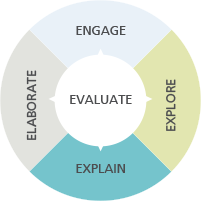LEARN! Manual Example #9
This example shows how the 5E model was applied when “Underveis”, a digital learning resource for secondary schools, was designed by the Norwegian Council for Road Safety.
Related Step
Design
Age Group
14 to 17 year olds
“Underveis” (meaning “along” or “underway”) is a learning resource for secondary schools in Norway, referring to the fact that youngsters are ‘on the way’ to growing up as road users. It used to be a printed magazine, but as of 2020, the content is digitised, providing more space to convert successful strategies and teaching methods from the physical classroom to the digital environment. Underveis 2021 includes four chapters, with 27 complete topics including formative and reflective assessments.
The Underveis website. Source: The Norwegian Road Safety Council
The reflective assessments were designed with the end in mind, and therefore the goals were set before the instructional methods were chosen. The goals embody the knowledge and skills the Norwegian Council for Road Safety wants the pupils to have learned when they complete each topic. Underveis includes films, tests, quizzes, information and a “crash calculator”. One of the themes covers seat belts and collisions, and focusses on how much of an impact one’s body can resist. It is primarily linked to science and mathematics, but teachers can also link the activity to social science, physical education, ethics, Norwegian and English.
When developing Underveis, the Norwegian Council for Road Safety took into account the importance of the flexible use of the 5E model. All the phases should be considered at the same time, with the focus moving back and forth between them. The learning objectives must be clear, and evaluation is part of the learning process throughout.

Engage
The 5E Model
Motivation, curiosity and interest were stimulated in different ways. The main question was: How can we meet the youngsters’ emotional needs and at the same time build the activity on scientific knowledge? The pupils should see the link between what they need and what they are learning. The process therefore starts with a film, with a subtitle that says: “To crash at 50 km/h without a seat belt is comparable to falling 10 metres. To crash at 90 km/h without a seat belt corresponds to a drop in height of 32 metres.” The film thereby provides the pupils with a common educational starting point.
Click on the image above to watch the video on YouTube.
To get the pupils engaged, the film was intended to be followed by some open questions for reflection. However, pre-tests showed that while girls responded well, boys did not. Based on this experience, the introduction was changed to simple written tasks containing a number of relevant questions for the pupils to answer. These tasks help to identify prior knowledge and attitudes and focus on the learning objectives. This example on how to engage also shows how evaluation was used in every step of the 5E model.
Explore
There are several activities that were designed to motivate the pupils to explore the topic. At every stage, they investigate, make their own decisions, gather information and ask questions. The tasks start with doing things, not just talking. One example of an activity can be seen in the image below where pupils are supposed to find the mistakes regarding the use of safety equipment.

Find the safety mistakes! In these three cars there are at least nine safety mistakes. Can you find them?
After the pupils’ discussion, they go to the next picture which provides explanations by clicking on the information icons.

Did you find the safety mistakes? Click on the info buttons below to see the mistakes and read the explanations.
Two examples of the explanations that are provided when clicking on a info button.
Explain
Through the digital learning process, Underveis shows the pupils how they can communicate their knowledge. For instance, after the pupils have explained what they discovered in these pictures, the teacher challenges their understanding of concepts and gives new examples to explain why it is so important to use safety equipment in the right way, or to load luggage securely.
Elaborate
When it comes to elaboration, the process uses another element in the learning course – the calculator – and looks at the forces at play in collisions.
When the pupils are exposed to the calculator, they are guided by a known example they have previously encountered – mobile phones used at different speeds at the time of a collision – before they can try with other objects. By entering the speed in km/h and the object’s weight into the calculator, they can see for themselves with what force the object would hit their bodies with. The link between reality and theory has been made.

More Information
An overview of classroom assessments.
The activity on identifying mistakes regarding the use of safety equipment.



